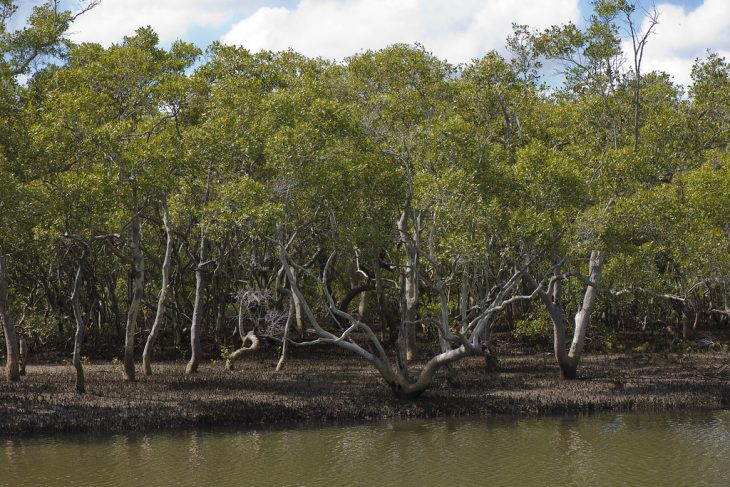The living organisms that we see around us are made up of billions or even trillions of cells. Multicellular organisms are often considered more complex than smaller single-celled organisms. Eukaryotes, a group that includes humans, have complex cells that are capable of forming large multicellular organisms. Bacteria and Archaea, on the other hand, were thought to be simple cells that never get large enough to see with the naked eye. However, new techniques have allowed the identification of microbes that are able to grow to a size of several hundred micrometers, about 100 times larger than the average size of known bacteria.
A group of researchers from France and the USA were investigating giant microorganisms that live in the sea water within mangrove forests, where they found strands of whitish bacteria over a centimeter long growing on sunken leaves. While several bacterial species are known to form filaments by chaining together multiple cells, each strand was made of just one long organism. The group named this organism Candidatus Thiomargarita magnifica, meaning magnificent (magnifica) sulfur pearl (Thiomargarita) that has not yet been cultured in a lab (Candidatus).
To understand how Candidatus Thiomargarita magnifica can grow so large, the researchers used several different dyes to highlight where compartments may form within the cell. Using a technique known as confocal laser scanning microscopy, which uses a focused beam of light and a special pinhole that blocks out-of-focus objects to produce images of everything in a sample at a certain depth, the team found many different compartments. One such compartment was a single giant vacuole, essentially a fluid-filled sack, in the center of the cell.
Many bacteria lack active ways to move nutrients around. Because of this, they must rely on chemical diffusion, the same process that causes milk to slowly spread out in coffee. On the scale of a few micrometers, diffusion is an efficient way to move nutrients around. On the other hand, larger cells cannot receive essential nutrients fast enough with diffusion and are forced to stay small or die.
However, the research team proposes that by having a large vacuole in its center, taking up much of the internal space, Candidatus Thiomargarita magnifica is able minimize the distance that nutrients need to move within the cell while also supporting its giant size.
While the large vacuole compartment was striking, the researchers noted many smaller membrane-bound compartments within the cell too. The team was curious as to whether these compartments might hold DNA, which could make them similar to the nucleus of eukaryotes. When the team used a DNA-specific dye called DAPI, they found that thousands of these compartments contained DNA. The team named these compartments pepins.
By then counting all of the DAPI-stained pepins, the research team found that Candidatus Thiomargarita magnifica had over 36,000 copies of its genome. In comparison, our human cells contain two copies of our genome and are called diploid cells. With so many copies of its genome, this giant is a polyploid cell and is able to use these copies individually to produce RNA.
Most of the pepins also had ribosomes which use RNA to produce proteins. This means that throughout its long, stalk-like structure, Candidatus Thiomargarita magnifica is able to create new proteins rather than wait for them to be shuttled over thousands of micrometers to reach the site where they are needed.
The researchers were curious about how a bacterium this large is able to procreate. By collecting many different samples, they found that Candidatus Thiomargarita magnifica produces small buds from the end of the cell which can then slowly grow to a fully matured, centimeter-long giant. During most cell divisions, proteins are produced that squeeze the middle of the cell together in order to pinch the parent cell in half, producing two new cells. However, this organism seems to lack many of these proteins. Instead, it has many copies of proteins that elongate and support the cell.
Finding a bacterium we can see with the naked eye calls many of the assumptions we make about life into question. The team notes that further research is needed to understand how this newly discovered organism regulates its metabolism, size, and many other functions. Although microbiologists have learned much, there is always something new to be discovered when it comes to the micro- and macro-scales of life.


